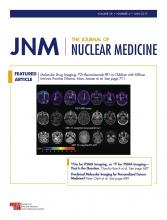REPLY: We agree that several confounding variables may be present in retrospective studies, but available data on thyroid cancer patients are mostly retrospective. Therefore, treatment strategies are based on low-level evidence and always open to challenge. The efficacy of radioactive iodine (RAI) treatment may be related to patient age, histology, lesion size and number, 18F-FDG uptake, treatment preparation (thyroid hormone withdrawal [THW] vs. recombinant human thyroid-stimulating hormone [rhTSH]), administered activity, number of treatments, cumulative activity, radiation dose to tumor foci, and assessment of response. Most of these factors were considered and discussed in our article (1).
Tulchinsky et al. point out the difference in mortality rate between French and American women, but this does not apply in our statistical analysis. We agree that patients who have metastatic disease and are younger than 20 y old frequently have an excellent response to RAI treatment, with previous reports showing a 100% 10-y survival rate at both Memorial Sloan Kettering Cancer Center (MSKCC) and Gustave Roussy (GR) (2,3). In our study, such patients represent 9.9% of the GR cohort (23/231) and 7.4% of the MSKCC cohort (9/121). When these patients are excluded from the analysis, the median age at the discovery of distant metastases is still younger for GR patients than for MSKCC patients (45 vs. 54 y, respectively; P = 0.01), but in the multivariate analysis, the difference in overall survival remains non–statistically significant (P = 0.16). Furthermore, there is still no difference in overall survival between the two centers in predefined matched subgroups of patients less than 40 y old: 5-y overall survival is 94% for both centers for group 1 (vs. 96% reported in our article) and 92% and 87% (with no changes in that reported in our article) for group 2 for GR and MSKCC patients, respectively.
We underlined in our discussion that a limit of the study was the imperfect matching between GR and MSKCC patients: MSKCC patients were older and had more aggressive disease. This is the population for whom it is most critical to define the best approach to improving overall survival, as noted by Flux et al. That is why we performed a separate analysis on predefined matched subgroups based on age and metastasis extent (3).
We agree with Tulchinsky et al. about the confounding bias of comparing the MSKCC approach (rhTSH preparation for dosimetry and treatment) with the GR approach (THW preparation for empiric administered activities). rhTSH preparation is not the standard approach in metastatic disease and may induce a lower RAI uptake than THW preparation. However, limited data from retrospective studies comparing RAI efficacy in metastatic cancer after THW or rhTSH did not show THW to have a clinically meaningful advantage over rhTSH in terms of overall survival or response to therapy (4,5). In our study, MSKCC patients received at least a 2- to 3-fold higher activity per treatment course after rhTSH-based whole-body/blood clearance (WB/BC) dosimetry than the empiric activities administered to GR patients after THW, and older patients with extensive disease received a 2-fold higher median cumulative activity. We found no benefit to overall survival, even considering the higher administered activities. The only other available retrospective study comparing the empiric versus the WB/BC dosimetry approach was on a smaller number of patients with metastatic disease and was only partially based on rhTSH-aided preparation; that study found no effect on PFS in either group (6). Only prospective studies including homogeneous groups of patients may clearly determine whether different preparations or the empiric versus the dosimetry-based approach can affect the efficacy of RAI.
In conclusion, in metastatic thyroid cancer, routine use of a WB/BC dosimetry management approach relying on high administered activities given under rhTSH preparation does not show a significant advantage over an empiric dosing approach using lower administered activities under THW preparation. However, as underlined by Flux et al., WB/BC dosimetry might be used in selected patients to minimize the risk of acute dose-related toxicities or in association with lesional dosimetry to optimize therapeutic efficacy. We strongly support the concept that the lesion-absorbed dose should be a major predictor of the tumoricidal effect of RAI, and in this context the combined use of WB/BC dosimetry and lesional dosimetry is expected to provide the optimally safe and effective individualized RAI activity to administer, as suggested from 124I PET studies (7). As underlined by Flux et al., optimal outcomes in patients with metastatic thyroid cancer can be achieved only through an integrated multidisciplinary management approach considering all of the various available treatment modalities (e.g., RAI, surgery, localized therapies, and new drugs, either as specific therapies or as redifferentiation agents to improve the efficacy of RAI).
Finally, to address the concerns of Tulchinsky et al., we would like to declare that there was no financial conflict of interest regarding the publication of our paper.
Footnotes
Published online Feb. 23, 2017.
- © 2017 by the Society of Nuclear Medicine and Molecular Imaging.







